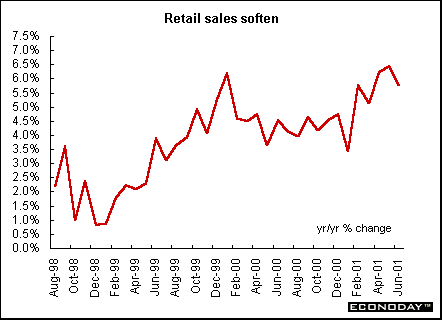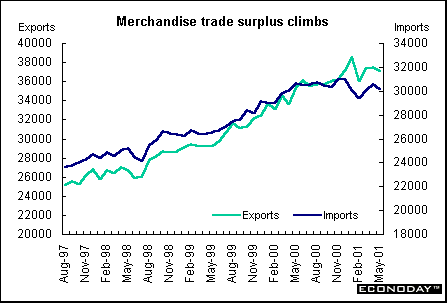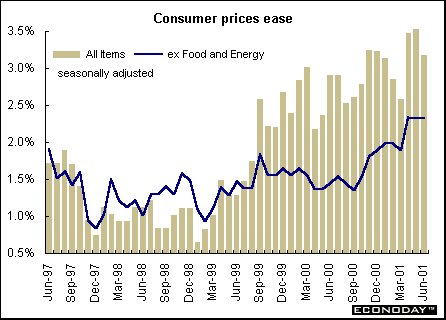
Indicator scoreboard
EMU - June harmonized index of consumer prices rose 0.1 percent and 3.0 percent when compared with last year. This is the second month that the increase has been above 3 percent. The ECB's price stability ceiling is 2 percent. HICP has been above 2 percent since June 2000. Core inflation - excluding energy, food, alcohol and tobacco - was 2.1 percent on the year. None of the 12 EMU states reported an annual inflation rate below 2.0 percent, while eight countries reported rates of 3.0 percent or above.

May industrial output declined 0.1 percent and was down 0.1 percent when compared with last year. This was the third month in a row that output has fallen. The data were revised downward for previous months. The 0.1 percent drop was also the lowest annual rate since May 1999 when output fell 0.2 percent on the year. Among individual categories, EMU consumer goods output fell, but capital goods output and intermediate output were up.

Germany - June wholesale prices declined 0.5 percent but rose 3.1 percent when compared with last year. Excluding oil products, wholesale prices dropped 0.4 percent but rose 2.8 percent on the year. Overall wholesale prices for energy products fell 0.9 percent. Manufacturing products excluding oil products were flat in June but up 2.6 percent on the year.
May manufacturing orders were revised up to 4.6 percent from the originally reported 4.4 percent. Similarly, west German orders were revised up to 5 percent from 4.8 and east German orders were revised up to 1.2 percent from 1 percent. Foreign orders were revised up to 9.4 percent from the originally reported 9 percent while domestic orders were revised up to 1.2 percent from 1 percent.

May real seasonally adjusted construction orders rose 1.3 percent but fell 2.7 percent after a decline of 5.4 percent when compared with last year. West German construction orders fell 1.9 percent and 1.1 percent on the year while in east Germany they jumped 12.8 percent but were down 7.6 percent on the year.
France - May seasonally and workday adjusted industrial output rose 0.3 percent and 1.6 percent when compared with last year. Manufacturing rose 0.3 percent but was up only 1.6 percent on the year. The manufacturing recovery after two months of decline was led by a rebound in auto production, which was up 1.5 percent. Consumer goods output fell 0.2 percent.
Italy - May seasonally and workday adjusted industrial production rose 0.3 percent, but fell 1.9 percent when compared with last year. Seasonally adjusted consumer goods output fell 0.6 percent on the month and fell 1.6 percent on the year. Output of investment goods rose 0.9 percent but was down 0.7 percent on the year, while intermediate goods rose by 0.4 percent but fell 2.4 percent on the year.
May industrial orders fell for the third month in a row, posting a 1.3 percent drop when compared with last year. Domestic orders were down 0.8 percent while foreign orders dropped 1.9 percent.
Britain - June retail price index (RPI) rose 0.1 percent and 1.9 percent when compared with last year. The retail price index excluding mortgage interest payments (RPIX) rose 0.2 percent and 2.4 percent on the year. The RPIX is used by the Bank of England to measure inflation. The Bank's inflation target is 2.5 percent.

Average earnings growth for the three months to May rose 4.5 percent, the Bank of England's target. This is down from 5.2 percent growth in the three months to April. Excluding bonuses, earnings rose by 5.1 percent in the year to May, only slightly down from 5.3 percent in April.

June seasonally adjusted claimant count measure of unemployment rate remained unchanged at 3.2 percent. The International Labour Organization measure of unemployment declined by 82,000 in the March through May period when compared to the previous three months. The ILO unemployment rate fell to 4.9 percent from 5.2 percent in the previous period, the lowest level since the series began in 1984.

June merchandise trade deficit with countries outside the European Union widened to Stg3.130 billion following a Stg2.448 billion shortfall in May. Imports surged 7.2 percent, far outstripping a 0.1 percent monthly fall in exports. Erratic items, including imports of aircraft and precious stones, boosted imports. Excluding oil and erratic items the non-EU deficit stood at only Stg2.0 billion, unchanged from last month. May global deficit narrowed to Stg2.421 billion in June following a Stg2.793 billion shortfall in May. The value of exports rose 2.1 percent while the value of imports dropped 0.2 percent.
June retail sales volumes were unchanged from May but up 5.6 percent when compared with last year. A decline in non-food sales offset a small gain in the food sector. In the three months to June the value of retail sales rose 2.2 percent compared with the previous three months and was up 7.1 percent on the same period a year ago.

Asia
Japan - Tokyo department store sales rose 3.8 percent in June from a year earlier as shoppers bought more summer accessories and clothing. June's gain followed a 0.1 percent decline in May. Consumer spending, which makes up about 55 percent of the economy, hasn't added to economic growth for the last three quarters. Sales were helped by an extra weekend day in June. Warmer weather helped boost sales of air conditioners, refrigerators and other household appliances 4.1 percent from a year earlier. Sales of clothing, which make up about 35 percent of the total for Tokyo department stores, rose 3.5 percent. Men's clothing sales rose 0.9 percent after falling for eight straight months.
Americas
Canada - May manufacturing shipments grew 2.1 percent for the strongest monthly gain since October 2000. The motor vehicle industry shipments jumped 5.5 percent. The computer and electronic products industry, which had been floundering because of a global slump in demand for communications related products, posted a 3.4 percent increase following April's 6.6 percent drop. Twelve of 21 industries, representing 74 percent of total shipments, rose. Unfilled orders rose for a second straight month, up 1.0 percent. The increase resulted from a 5.8 percent expansion in orders of the aerospace products and parts industry. Excluding aerospace, unfilled orders were down 2.3 percent. New orders rose 1.8 percent. Excluding the aerospace product and parts industry, new orders increased 2.0 percent.
May merchandise trade surplus rose to C$6,965 million from April's C$6,897 million surplus. Both exports and imports fell. Exports fell 0.9 percent as global demand for high-tech equipment continued its decline. Imports were down 1.4 percent because of slumping automotive and machinery and equipment imports, which more than offset sharp increases in incoming energy products and industrial goods and materials. Merchandise exports to the United States declined 1.1 percent while imports from south of the border fell 1.1 percent. As a result, the trade surplus with the United States dropped slightly, from C$9.6 billion in April to almost C$9.5 billion in May. Exports declined in May in all major categories except agricultural and fishing products. Hardest hit was high-tech equipment, such as computers and optical network equipment, as global demand continued its decline. Strong increases in imports of energy products and industrial goods and materials weren't enough to offset declines in imports in other major sectors.

June consumer price index rose 0.1 percent and 3.3 percent when compared with last year. The greatest upward pressure came from rising prices for electricity, traveler accommodations, air transportation, women's' clothing and restaurant meals. Partly offsetting these effects were lower prices for gasoline and men's clothing. The CPI excluding food and energy was 2.0 percent on the year. A new Bank of Canada core index, which excludes the eight most volatile components, was 2.3 percent, the same as for May.



Introduction • Global
Stock Market Indexes • Recap of Global Markets
• Currencies • Indicator
Scoreboard

The Bottom Line •
Looking Ahead
|